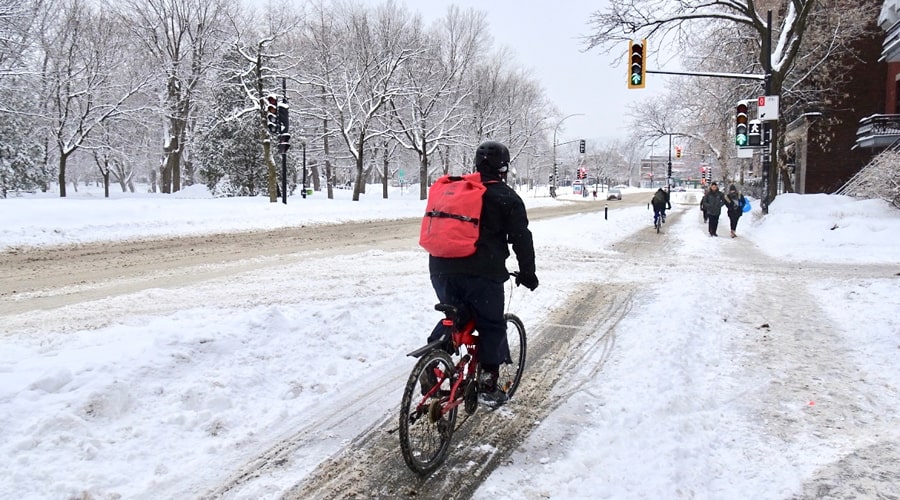
Tip: Things freeze in winter! Always remember to keep a small bottle of bike lock de-icer in your bag or coat pocket in order to avoid starting your day late and in a bad mood. (very affordable and convenient, available in hardware or bike stores).

Accueil Toolkits Cycling Winter Cycling Adapt your bike for winter
Have a bike and want to ride it during the winter? There is no perfect bike for cold weather – every cyclist has his own preferences. So to get initiated, you can definitely use the good old bike that gets you around every other month of the year!
Few excerpts from these tips and advice are taken from the 2 roues, 4 saisons d’ENvironnement JEUnesse campaign.

Tip: Things freeze in winter! Always remember to keep a small bottle of bike lock de-icer in your bag or coat pocket in order to avoid starting your day late and in a bad mood. (very affordable and convenient, available in hardware or bike stores).
In winter, the days are shorter and you will often be biking in the dark. To stay safe, equip your bike with lights – white in the front and red in the back.
Tip: If your route is dimly lit, you will need a headlight of about 150 lumens or more to help you see clearly. On a well-lit route, a headlight of 60 to 150 lumens will help other road users see you.
Tip: Since cold weather is tough on batteries, remember to recharge them frequently or carry spare lights.
Tip: If the road is slippery, you can reduce the pressure of your tires. However, be careful not to go below the minimum pressure recommended by the manufacturer (follow the directions indicated on the edge of your tires). A slightly softer tire will give you better grip.
Studded: Designed for snow, cold and ice, these tires will provide good traction on slippery roads thanks to their studded ridges. However, they are quite expensive. They are also heavier, making for a slower, more challenging ride.
Cyclocross: Multipurpose, inexpensive! Since they are quite narrow, they effectively cut through snow, even in deep layers, to the pavement. However, they do not perform well on ice. Bike with caution. Affordable price.
Mountain: Also very affordable, these wide studded tires hug the road well, even in wet conditions. However, they do not provide the same traction on snowy or icy surfaces. Bike with caution. Affordable price.
Derailleur(s): This is the most conventional system on the market, since derailleurs are usually affordable and quite reliable. However, they can freeze in extremely cold weather. It is therefore advisable to opt for a ratio that suits us and avoid changing speeds.
Internal Gear Hub: Since the gears are protected inside the hub, there is practically no risk of breakage. The system functions effectively under all conditions, although it will weigh down your bike. It is also a bit more expensive.
Single Speed (fixed and standard cog): The fewer the parts, the lower the risk of breakage! However, since there is only one speed, it is sometimes more difficult to get going. Be aware that the free wheel of the standard single speed can freeze in extreme cold. And fixed cog enthusiasts should have at least one emergency brake!
On rims (V-brake, cantilever): Their jaws close on the rim of the wheel. This type of brake is quite effective, although less so when the road is wet. Be careful of ice when the temperature fluctuates. Also the rims and brake pads tend to wear out prematurely in winter.
Backpedal: Since it is integrated into the hub, it is a very reliable system, regardless of the conditions. However, the bicycle will be more inclined to skid with this braking system; a minimum amount of practice is required before hitting the road, and a backup brake is recommended.
Disc: This system is very effective under all conditions, but is quite fragile. It requires a bit of maintenance and, depending on the quality, is relatively expensive compared to other braking systems.
Drum: A good choice in all weather conditions. A sustainable purchase that requires little maintenance, since it is protected from bad weather. However, the emergency braking is less reliable than other systems – keep your distance! Weakness: it is very heavy and requires a compatible hub.
Tip: Consider slightly lowering the height of your seat at the beginning of winter. The icy road and difficult conditions will sometimes require you to put your foot on the ground quickly to come to a stop or keep your balance. You can raise it again once the warm weather returns!
Watchword: lubrication! Don’t forget about your chain – otherwise, you may have to forget about winter biking! Use a more viscous chain lubricant than in the summer, so that it lasts more than 24 hours under damp conditions. However, remember to wipe off the excess with a cloth to prevent it from accumulating dirt as soon as you clean it. You can then apply a more liquid lubricant, if necessary.
Also consider lubricating other bike parts (braking system, spoke nuts, derailleur, drive, etc.) a few times during the winter, in order to improve performance and reduce the risk of freezing.
En devenant membre de Vélo Québec, vous appuyez notre mission de développer et promouvoir la pratique du vélo et contribuez avec nous à bâtir le Québec à vélo de demain.
